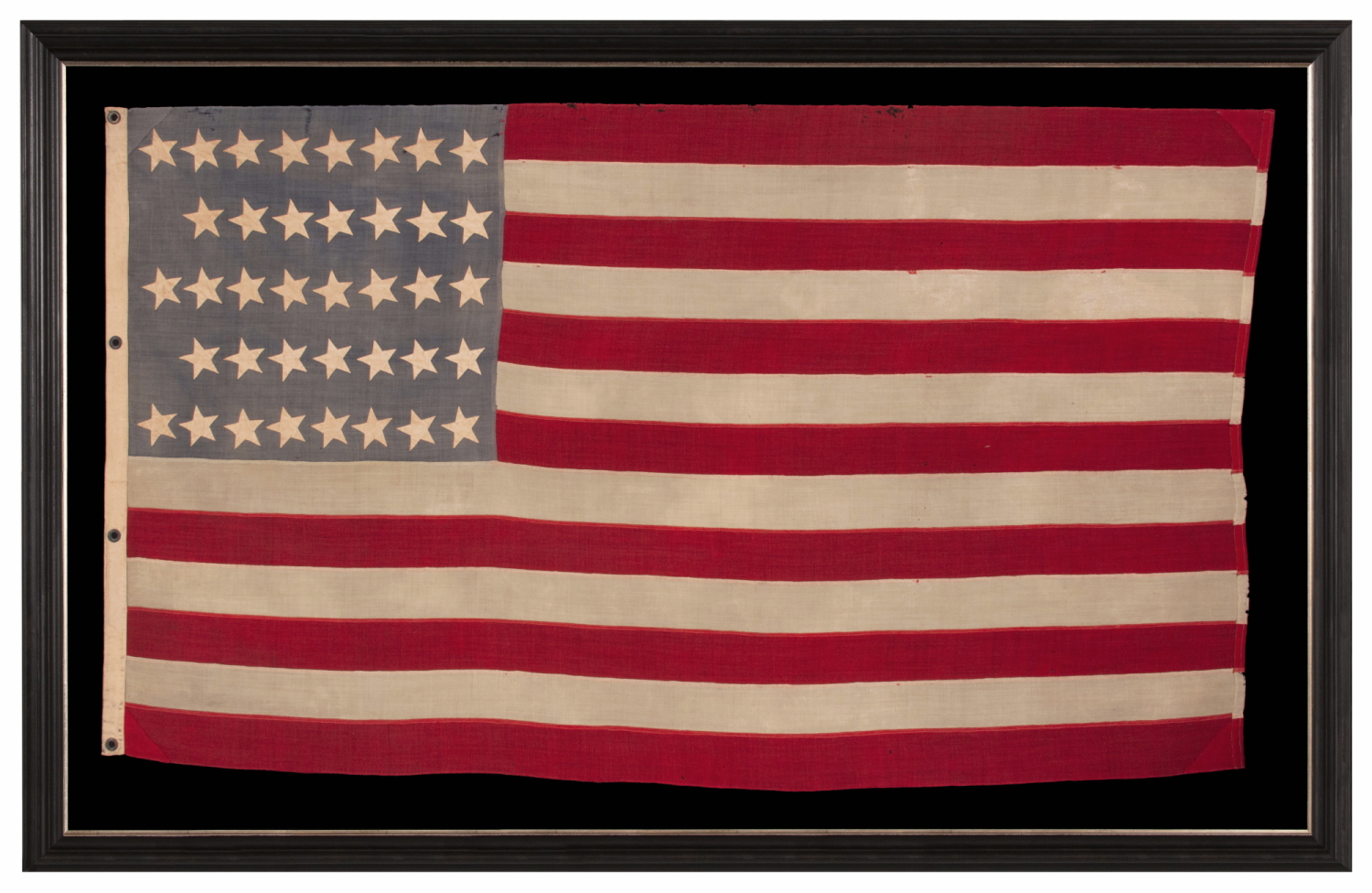


| 38 STARS IN A "NOTCHED" PATTERN, ON AN ANTIQUE AMERICAN FLAG WITH A DUSTY BLUE CANTON; LEAVES SPACE FOR MORE WESTERN TERRITORIES THAT HAD NOT YET JOINED THE UNION; REFLECTS COLORADO STATEHOOD, 1876-1889 |
|
| Web ID: | 38j-1169 |
| Available: | In Stock |
| Frame Size (H x L): | Approx. 62.5" x 98" |
| Flag Size (H x L): | 50" x 85" |
| Description: | |
| 38 star Antique American flag, made during the period when Colorado was the most recent state to join the Union. The stars are arranged in rows of 8-7-8-7-8, justified in what is known as a "notched" pattern. This leaves two spaces open along the hoist end, in the second and fourth rows, in anticipation that two more Western Territories would soon join the Union. The latter 19th century was a time when much of the land in and about the Continental Divide was formalized into states, and there was continual speculation about which ones would be accepted next, and with what boundaries. Note how the canton has faded to a dusty blue-grey. Some of the blue wool bunting acquired by flag-makers near the opening of the last decade of the 19th century, and sometimes shortly thereafter, was produced with a fugitive dye, breaking down on its own, fading whether or not it was exposed to light. The result is actually more pleasing than one would expect, often contributing a positive element to a flag’s overall appearance, rather than detracting from it, while lending a trait that assists in the visual translation of its age. The stars of the flag are made of cotton and are double-appliquéd (applied to both sides). These are hand-sewn on the obverse (front) and treadle-stitched on the reverse. This manner of construction is not unusual in this period, which was transitional between the Civil War (1861-1865), when most all stars were hand-sewn, and the turn-of-the-century (1900), when most were stitched by machine. The canton and stripes of the flag are made of wool bunting that has been pieced and joined with treadle stitching. The canton was constructed from two separate lengths of fabric. Because wool bunting was most often available in a width of eighteen inches, anything larger than this would necessitate multiple lengths of cloth. The triangular patches in all four corners of the flag are gussets and are original to the flag’s construction. These were included for extra support, in locations where the flag generally received the most wear. There is a heavy, twill cotton binding along the hoist, with 4 large brass grommets, evenly spaced. This manner of construction is more indicative of flags intended to be flown at sea, where there were few barriers from the wind and greater longevity was desired. Colorado became the 38th state on August 1st, 1876. This was the year of our nation’s 100-year anniversary of independence. Per the Third Flag Act of 1818, stars were not officially added until the 4th of July following a state's addition. For this reason, 37 was the official star count for the American flag in 1876. Flag-making was a competitive venture, however, and few flag-makers would have been continuing to produce 37 star flags, when their competitors were making 38’s. It is for this reason that 38 and 13 stars (to represent the original 13 colonies) are more frequently encountered at the Centennial International Exposition, the six-month long World’s Fair, held in Philadelphia, in honor of the event. Some flag-makers would have been adding a star for the 38th state even before it entered the Union, in the early part of 1876 or even prior. In fact, many makers of printed parade flags were actually producing 39 star examples, in hopeful anticipation of the addition of two more Western Territories instead of one. The 39th state would not join the Union for another 13 years, however, when the Dakota Territory entered as two states (numbers 39 and 40) on the same day, on November 2nd, 1889. The 38 star flag generally fell out of production at that time, though it technically remained official until July 3rd, 1890. President Ulysses S. Grant was in office when the first 38 star flags would have appeared. The list of presidents serving during the period when the 38 star flag was actually official, include Rutherford B. Hayes, James Garfield, Chester Arthur, Grover Cleveland, and Benjamin Harrison. Mounting: The flag was mounted and framed within our own conservation department, which is led by expert trained staff. We take great care in the mounting and preservation of flags and have framed thousands of examples. Extensive time and care were undertaken in the conservation stitching of the losses along the fly end. The background is 100% cotton twill, black in color, that has been washed and treated for colorfastness. The black-painted and hand-gilded molding, with its wide, serpentine profile, is Italian. The glazing is U.V. protective acrylic (Plexiglas). Feel free to contact us for more details. Condition: In addition to the fugitive dye used in the canton, as discussed above, there is modest to moderate mothing in the canton and the stripes, the most significant of which occurs along the top edge of the canton and the first 4 stripes. There is minor mothing in limited areas elsewhere. There is minor to modest golden oxidation of the white hoist binding and the stars. Many of my clients prefer early flags to show their age and history of use. |
|
| Video: | |
| Collector Level: | Intermediate-Level Collectors and Special Gifts |
| Flag Type: | Sewn flag |
| Star Count: | 38 |
| Earliest Date of Origin: | 1876 |
| Latest Date of Origin: | 1889 |
| State/Affiliation: | Colorado |
| War Association: | 1866-1890 Indian Wars |
| Price: | Please call (717) 676-0545 or (717) 502-1281 |
| E-mail: | info@jeffbridgman.com |
 |
|